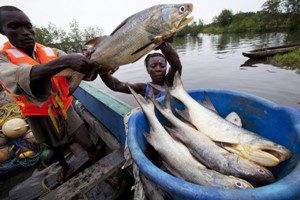Cote d’Ivoire, which produces 5,000 tons of fish products per year, needs 500,000 tons of fish to cover the consumption needs of its population estimated at 25 million inhabitants.
“It is practically 500,000 tons of fish that are needed in Cote d’Ivoire to cover the consumption needs of its population estimated at 25 million people,” said Wednesday Mr. Sidi Toure, the Ivorian Minister of Animal Resources and Fisheries.
Mr. Toure was speaking at the opening of a workshop to validate the analysis of the tilapia aquaculture value chain in Cote d’Ivoire (FISH4ACP), in the premises of the African Center for Management and Executive Development (CAMPC), at the University Felix Houphouet-Boigny.
In Cote d’Ivoire, he said, the contribution of aquaculture to the national production of fishery products is about 5,000 tons. This sub-sector represents about 14,000 jobs including 6,000 direct jobs and about 8,000 indirect jobs.
Fish is the main source of animal protein for the consumer in Cote d’Ivoire with a consumption of about 24.9 kg per year and per inhabitant. The national fisheries production covers only 20 percent of the country’s needs.
Imports of fishery products, per year, result in significant outflow of foreign currency, about 100 billion CFA francs, while the country is full of natural assets to be among the leading countries in aquaculture production worldwide, he said.
The FISH4ACP Project, initiated by the Organization of African, Caribbean and Pacific States, is a program for the sustainable development of fisheries and aquaculture value chains. It is funded by the European Union (EU) and the German Federal Ministry.
Mr. Stephane Brossard, in charge of incisive growth, representing the head of the EU delegation in Côte d’Ivoire, said that the institution has decided to support this project in 10 African and Pacific countries for an amount of 40 million euros, or more than 26 billion CFA francs.
The German cooperation has contributed 10,000 million euros, or 6.5 billion CFA francs. This project aims to develop the enormous potential of activities and economic growth in the aquaculture sector in these regions.
“Our challenge is that the growth is the most inclusive and sustainable possible with quality jobs, decent jobs, management of natural water resources and the issue of pollution and numerical prices,” Mr. Brossard said.
For the representative of the FAO Resident Representative, Zoungrana Mahama, “it is difficult to understand” that with the potential that abounds in Côte d’Ivoire in terms of water resources, skills at the level of actors, the country imports more than 80 percent of its fish consumption.
“That is why this project aims to take stock of the challenges of the sector (and) understand the constraints encountered to reverse the trend by allowing stakeholders to have access to tilapia in sufficient quantities to balance their need for food security,” he said.
According to FAO forecasts, aquaculture will provide 62 percent of fish production for consumption by 2030. It has also become the unavoidable alternative to the growing demand for fish products.
AP/ls/fss/abj/APA


